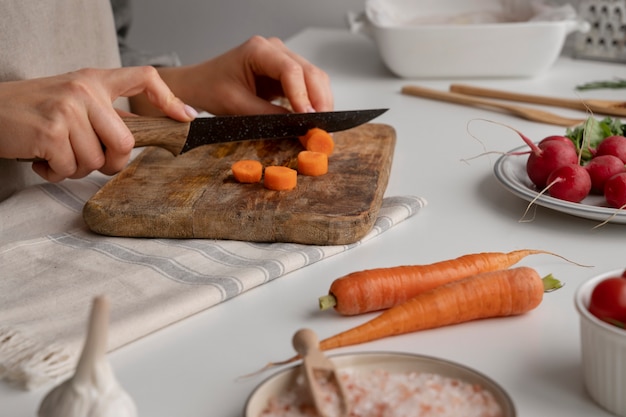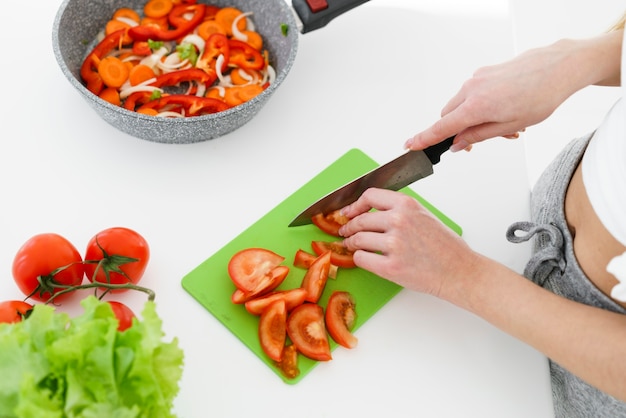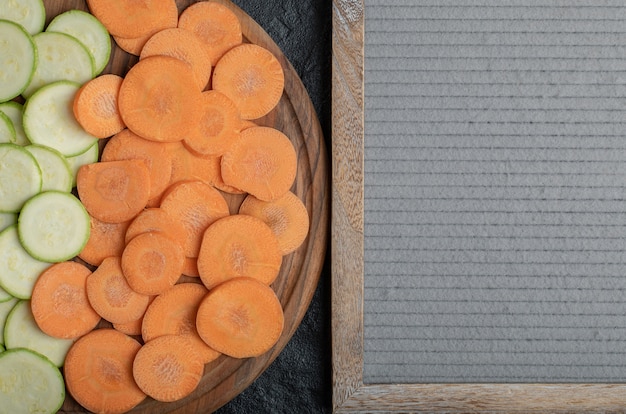Carrots are a kitchen staple for a reason. They’re inexpensive, readily available, and incredibly versatile. But sometimes, we get stuck in a rut with the same old boiled carrots, right? So, I'm going to share everything I’ve learned about cooking carrots – from the simplest methods to more adventurous techniques. We’ll cover how to choose the best carrots, the best ways to prep them, how to cook them to perfection, and even some delicious ways to use them in different dishes. Buckle up, this is a carrot adventure you won't want to miss!
(Part 1) Getting Started: Choosing and Preparing Your Carrots

The first step to delicious carrots is choosing the right ones. You’ll want to look for carrots that are fresh, firm, and vibrant. Trust me, you’ll taste the difference.
Choosing the Best Carrots: A Guide to Quality
Here's how to pick the perfect carrots:
- Firmness: A good carrot should feel firm to the touch, not soft or mushy.
- Smooth Skin: Look for carrots with smooth, unblemished skin. Avoid those with deep wrinkles or cracks.
- Vibrant Colour: Opt for carrots that are a deep, rich orange. A dull orange colour could mean they're older.
- Fresh Tops: If the tops are still attached, make sure they're fresh and green. This is a sign of a healthy carrot.
- Size Matters: Large carrots are perfect for roasting, while smaller carrots work best for stir-frying or quick cooking methods.
Preparing Carrots for Cooking: Getting Ready for Flavor
Now that you’ve chosen the perfect carrots, it's time to get them ready for cooking.
- Wash Thoroughly: Rinse your carrots under cold running water to remove any dirt or debris.
- Trim the Ends: Snip off the top and bottom of the carrots with a sharp knife.
- Scrub or Peel: I'm a firm believer in keeping the skin on for added flavor and fiber. Scrub them well with a vegetable brush, but if you prefer, peel them.
- Slice, Dice, or Chop: Cut your carrots into the size you need based on your recipe. A sharp chef's knife is a must-have for this task. You can also use a mandoline for thin ribbons or a spiralizer for carrot noodles.
(Part 2) The Basics: Mastering the Art of Boiling and Steaming

Boiling and steaming are the simplest ways to cook carrots, ensuring they're tender and easy to digest. But even these basic methods have their own tricks for achieving the best results.
Boiling Carrots to Perfection: A Simple and Classic Technique
Here's how to make perfectly boiled carrots:
- Bring Water to a Boil: Fill a large saucepan with water and bring it to a rolling boil.
- Add Carrots: Gently add the carrots to the boiling water.
- Cook Until Tender: Boil the carrots until they're fork-tender, but still hold their shape. This will take about 5-7 minutes for small carrots and 10-15 minutes for larger ones.
- Test for Doneness: Pierce the carrots with a fork. If it slides in easily, they're ready.
- Season with Salt: Add a pinch of salt to the boiling water. This seasons the carrots and prevents them from becoming too soft.
Remember, don't overcook your carrots. You want them tender but not mushy.
The Steaming Method: A Healthier Way to Cook
Steaming is a great option for preserving more nutrients and preventing carrots from absorbing too much water. Here's how to steam carrots:
- Heat Water: Fill a saucepan with about an inch of water. Bring it to a boil.
- Place Steamer Basket: Position a steamer basket over the boiling water.
- Add Carrots: Place the carrots in the steamer basket.
- Cover and Steam: Cover the pan and steam the carrots for about 5-10 minutes, depending on their size.
For a subtle flavor boost, add fresh herbs like dill or parsley to the water while steaming.
(Part 3) Roasting: The Ultimate Way to Enhance Flavour

Roasting carrots brings out a caramelized sweetness that other cooking methods simply can’t match. They become tender, slightly crispy, and perfect for side dishes, salads, or even as a delicious snack.
Roasting Carrots: Simple and Delicious
Here's a basic roasted carrot recipe that's guaranteed to impress:
- Preheat Oven: Preheat your oven to 400°F (200°C).
- Toss with Oil and Seasonings: Drizzle your carrots with olive oil and season generously with salt, pepper, and your favorite herbs. I love rosemary, thyme, and garlic powder.
- Roast on Baking Sheet: Spread the carrots in a single layer on a baking sheet.
- Roast Until Tender and Caramelized: Roast for 20-25 minutes, or until the carrots are tender and starting to turn a lovely golden brown.
- Add a Squeeze of Lemon: For a final touch of brightness, squeeze a little lemon juice over the roasted carrots.
Beyond the Basics: Experimenting with Flavors
Let’s get creative! Here are some variations on the classic roasted carrot recipe:
- Honey-Glazed Carrots: Before roasting, drizzle the carrots with honey for a sticky, sweet glaze.
- Spicy Carrots: Add a pinch of chili flakes or cayenne pepper to the oil mixture for a spicy kick.
- Ginger-Garlic Carrots: Stir in minced ginger and garlic to the olive oil for a fragrant and flavorful twist.
- Citrus Burst: Roast the carrots with a squeeze of orange or grapefruit juice for a tangy flavor.
- Herbed Delight: Experiment with different herbs like oregano, sage, or basil for unique flavor profiles.
(Part 4) Stir-Frying: Quick and Easy for Weeknight Meals
Stir-frying is a lifesaver on busy weeknights. It’s fast, easy, and perfect for adding carrots to a variety of dishes.
Stir-Frying Carrots: A Versatile Technique
Here’s how to stir-fry carrots like a pro:
- Heat Wok or Pan: Heat a wok or large frying pan over medium-high heat.
- Add Oil: Add a tablespoon of oil, such as vegetable or sesame oil.
- Stir-Fry Carrots: Add the diced carrots and stir-fry for 5-7 minutes, or until they’re tender-crisp.
- Add Other Vegetables: Stir-fry other vegetables like onions, peppers, or broccoli with the carrots. Remember to add them in order of their cooking times, with the vegetables that take longer to cook going in first.
- Season and Sauce: Season with salt and pepper. You can also add a sauce like soy sauce and ginger, sweet and sour, curry, or peanut sauce.
(Part 5) Braising: A Gentle Approach for Tender and Flavorful Carrots
Braising is a slow and gentle cooking method that creates the most tender and flavorful carrots. You can add them to soups, stews, or even make them the star of the show with a beautiful braised carrot dish.
Braising Carrots: Slow and Steady Wins the Race
Here’s how to braise carrots to perfection:
- Sauté Carrots: Heat a large pot or dutch oven over medium heat. Add a tablespoon of olive oil and sauté the sliced or diced carrots for 5 minutes, or until they begin to soften.
- Add Aromatics: Add aromatics like onions, garlic, and herbs to the pot and cook for another minute or two.
- Add Braising Liquid: Pour in your braising liquid – this could be broth, wine, or even just water – and bring the mixture to a simmer.
- Simmer Until Tender: Cover the pot and simmer until the carrots are very tender, about 30-45 minutes.
Braised Carrot Variations: Explore Different Flavors
Try these braised carrot variations to take your tastebuds on a journey:
- Classic Braised Carrots: Use beef or vegetable broth for a simple and flavorful braising liquid.
- Red Wine Braised Carrots: Use red wine and a bit of orange zest for a luxurious and slightly sweet braised carrot dish.
- Spiced Braised Carrots: Add cumin, coriander, and cinnamon to the broth for a warm and aromatic flavor profile.
- Maple-Glazed Braised Carrots: Combine maple syrup, Dijon mustard, and a pinch of red pepper flakes for a sweet and savory glaze.
(Part 6) Using Carrots in Different Dishes: A culinary adventure
Carrots are incredibly versatile. They can be used in a wide range of dishes, adding sweetness, colour, and texture to everything they’re in.
Sweet and Savory Soups: Carrots as a Soup Star
Carrots are a natural addition to soups. They enhance classic vegetable soups, add depth to creamy carrot and ginger soups, and even bring a touch of sweetness to spicy Thai curries.
Hearty and Comforting Stews: Carrots for a Warm Embrace
Add carrots to your favourite beef stew, lamb stew, or chicken stew for a touch of sweetness and a thickening agent for the sauce.
Invigorating Salads: Carrots for Crunch and Colour
Use shredded or sliced carrots in salads. They add a welcome crunch and a burst of colour. Roasted carrots bring a more caramelized and intense flavour to your salad.
Delicious Desserts: Carrots in Sweet Treats
Yes, you read that right! Carrots can be used in desserts! carrot cake is a classic, but you can also add grated carrots to muffins, cookies, and even bread for a touch of sweetness and moisture.
(Part 7) Experimenting with Different carrot varieties: A World of Flavors
While orange carrots are the most common, there’s a whole rainbow of carrot varieties out there, each with its own unique flavour and colour. It’s fun to explore the diversity of carrots and discover new favorites.
A Rainbow of Carrots: Beyond the Orange
Here are a few of the many carrot varieties you might encounter:
- Purple Carrots: Known for their sweet and earthy flavour.
- Yellow Carrots: Milder and sweeter than orange carrots, great for adding colour to salads.
- White Carrots: Have a mild, almost nutty flavour.
- Red Carrots: The sweetest of them all, with a hint of spice.
- Rainbow Carrots: These are a mix of orange, yellow, purple, and red carrots, offering a beautiful display and a variety of flavors.
Discovering New Flavors: Embrace the Diversity
Don't be afraid to venture beyond the familiar orange carrot. The next time you’re at the market, try a different variety. You might be surprised by the delightful flavors you discover.
(Part 8) Preserving Carrots: Making the Most of Your Harvest
If you have a bountiful garden overflowing with carrots, you might want to learn how to preserve them to enjoy their flavour year-round.
Freezing Carrots: A Simple Preservation Method
Freezing carrots is a simple and effective way to preserve them. Here’s how to do it:
- Wash and Cut: Wash and scrub your carrots, then cut them into the size you prefer.
- Blanch: Blanch the carrots in boiling water for a few minutes, then immediately plunge them into an ice bath to stop the cooking process.
- Dry and Freeze: Dry the carrots thoroughly, then freeze them in freezer bags or containers.
Pickling Carrots: A Delicious and Tangy Treat
Pickling carrots adds a delightful tangy flavour. You can pickle them whole, sliced, or diced. There are numerous pickling recipes available, so you can find one that suits your taste.
Drying Carrots: A Long-Lasting Option
Drying carrots creates a long-lasting, shelf-stable option. You can dry them in a food dehydrator or in the oven on a low setting. Dried carrots can be rehydrated and used in soups, stews, and other dishes.
(Part 9) FAQs: Answers to Your Burning Questions
I've been asked many questions about carrots over the years, so here are answers to some of the most common ones.
1. What is the best way to store carrots?
Store carrots in the crisper drawer of your refrigerator in a plastic bag or wrapped in paper towels. This will help keep them fresh and crisp for up to a week.
2. Can I use frozen carrots in recipes?
Yes, absolutely! You can use frozen carrots in any recipe that calls for fresh carrots. Just make sure to adjust the cooking time accordingly, as frozen carrots will cook more quickly.
3. Are carrots good for you?
Absolutely! Carrots are packed with nutrients, including vitamin A, vitamin K, and potassium. They're also a good source of fibre.
4. Can I eat the carrot greens?
Yes, carrot greens are edible and they’re actually quite delicious! They have a slightly bitter flavour, but they’re packed with nutrients, especially vitamins A and K. You can eat them raw, sauté them, or use them in soups and stews.
5. What’s the best way to cook carrots for kids?
Getting kids to eat their vegetables can be a challenge. But carrots are a good starting point. Try roasting them with a little bit of honey, or steaming them with a touch of cinnamon for a sweet and fragrant treat. You can even turn them into fun shapes using cookie cutters, which is always a hit with the little ones!
And there you have it! My ultimate guide to cooking carrots. I hope this has inspired you to get creative in the kitchen and explore all the amazing ways to cook this humble but versatile vegetable. Enjoy!
Everyone is watching

Prime Rib Roast Cooking Time Chart: Per Pound Guide
Cooking TipsPrime rib roast. Just the name conjures images of lavish dinners, crackling fires, and hearty laughter. It’s ...

How Long to Bake Potatoes in the Oven (Perfect Every Time)
Cooking TipsBaked potatoes are a staple in my kitchen. They're incredibly versatile, delicious, and surprisingly easy to m...

Perfect Rice Every Time: The Ultimate Guide to Cooking Rice
Cooking TipsAs a self-proclaimed foodie, I've always been a bit obsessed with rice. It's the foundation of countless cuisi...

The Ultimate Guide to Cooking Asparagus: Tips, Techniques, and Recipes
Cooking TipsAsparagus. The mere mention of this spring delicacy conjures up images of vibrant green spears, crisp and burs...

Ultimate Guide to Cooking the Perfect Thanksgiving Turkey
Cooking TipsThanksgiving. Just the word conjures up images of overflowing tables laden with delicious food, the scent of r...
